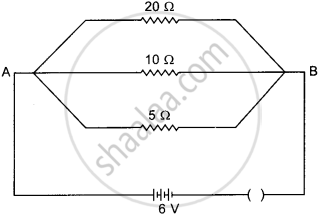Advertisements
Advertisements
Question
Two resistances when connected in parallel give resultant value of 2 ohm; when connected in series the value becomes 9 ohm. Calculate the value of each resistance.
Solution
Let the resistances of the two resistors be x and y.
When they are connected in parallel, we have:
1 / x + 1 / y = 1 / 2 ... (1)
When they are connected in series, we have:
x + y = 9 ... (2)
On solving equations (1) and (2), we will obtain the values of the two resistors as 3 Ω and 6 Ω.
APPEARS IN
RELATED QUESTIONS
How can three resistors of resistances 2 Ω, 3 Ω and 6 Ω be connected to give a total resistance of 4 Ω ?
State how are the two resistors joined with a battery when equivalent resistance is less than either of the two resistances.
You have three resistors of values 2Ω, 3Ω and 5Ω. How will you join them so that the total resistance is less than 1Ω? Draw diagram and find the total resistance.
Solve the following question:
In an electric circuit, two resistors of 12 0 each are joined in parallel to a 6 V battery. Find the current drawn from the battery.
How does the resistance of a metallic wire depend on the length of wire?
How does the resistance of a metallic wire depend on the thickness of wire?
Calculate the current flows through the 10 Ω resistor in the following circuit.


The diagram above is a schematic diagram of a household circuit. The house shown in the above diagram has 5 usable spaces where electrical connections are made. For this house, the mains have a voltage of 220 V and the net current coming from the mains is 22A.
- What is the mode of connection to all the spaces in the house from the mains?
- The spaces 5 and 4 have the same resistance and spaces 3 and 2 have respective resistances of 20Ω and 30Ω. Space 1 has a resistance double that of space 5. What is the net resistance for space 5.
- What is the current in space 3?
- What should be placed between the main connection and the rest of the house’s electrical appliances to save them from accidental high electric current?
Two V-I graphs A and B for series and parallel combinations of two resistors are as shown. Giving reason state which graph shows (a) series, (b) parallel combination of the resistors.

Two resistors having resistance 8 Ω and 12 Ω are connected in parallel. Find their equivalent resistance.
